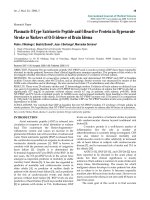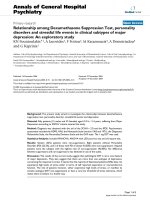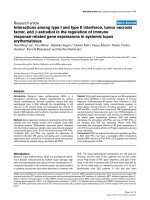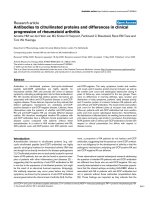Báo cáo y học: "Interactions among type I and type II interferon, tumor necrosis factor, and -estradiol in the regulation of immune response-related gene expressions in systemic lupus erythematosus" potx
Bạn đang xem bản rút gọn của tài liệu. Xem và tải ngay bản đầy đủ của tài liệu tại đây (1.46 MB, 10 trang )
Open Access
Available online />Page 1 of 10
(page number not for citation purposes)
Vol 11 No 1
Research article
Interactions among type I and type II interferon, tumor necrosis
factor, and -estradiol in the regulation of immune
response-related gene expressions in systemic lupus
erythematosus
Hooi-Ming Lee
1
, Toru Mima
1
, Hidehiko Sugino
1
, Chieko Aoki
1
, Yasuo Adachi
1
, Naoko Yoshio-
Hoshino
1
, Kenichi Matsubara
2
and Norihiro Nishimoto
1
1
Laboratory of Immune Regulation, Graduate School of Frontier Biosciences, Osaka University, 1-3 Yamada-Oka, Suita City, Osaka 565-0871, Japan
2
DNA Chip Research Incorporated, 1-1-43 Suehirocho, Tsurumi-ku, Yokohama, Kanagawa 230-0045, Japan
Corresponding author: Norihiro Nishimoto,
Received: 28 Aug 2008 Revisions requested: 2 Oct 2008 Revisions received: 14 Nov 2008 Accepted: 3 Jan 2009 Published: 3 Jan 2009
Arthritis Research & Therapy 2009, 11:R1 (doi:10.1186/ar2584)
This article is online at: />© 2009 Lee et al.; licensee BioMed Central Ltd.
This is an open access article distributed under the terms of the Creative Commons Attribution License ( />),
which permits unrestricted use, distribution, and reproduction in any medium, provided the original work is properly cited.
Abstract
Introduction Systemic lupus erythematosus (SLE) is a
prototypical autoimmune disease characterized by various
clinical manifestations. Several cytokines interact and play
pathological roles in SLE, although the etiopathology is still
obscure. In the present study we investigated the network of
immune response-related molecules expressed in the peripheral
blood of SLE patients, and the effects of cytokine interactions on
the regulation of these molecules.
Methods Gene expression profiles of peripheral blood from SLE
patients and from healthy women were analyzed using DNA
microarray analysis. Differentially expressed genes classified
into the immune response category were selected and analyzed
using bioinformatics tools. Since interactions among TNF, IFN,
-estradiol (E2), and IFN may regulate the expression of
interferon-inducible (IFI) genes, stimulating and co-stimulating
experiments were carried out on peripheral blood mononuclear
cells followed by analysis using quantitative RT-PCR.
Results Thirty-eight downregulated genes and 68 upregulated
genes were identified in the functional category of immune
response. Overexpressed IFI genes were confirmed in SLE
patient peripheral bloods. Using network-based analysis on
these genes, several networks including cytokines – such as
TNF and IFN – and E2 were constructed. TNF-regulated genes
were dominant in these networks, but in vitro TNF stimulation on
peripheral blood mononuclear cells showed no differences in
the above gene expressions between SLE and healthy
individuals. Co-stimulating with IFN and one of TNF, IFN, or
E2 revealed that TNF has repressive effects while IFN
essentially has synergistic effects on IFI gene expressions in
vitro. E2 showed variable effects on IFI gene expressions among
three individuals.
Conclusions TNF may repress the abnormal regulation by IFN
in SLE while IFN may have a synergistic effect. Interactions
between IFN and one of TNF, IFN, or E2 appear to be involved
in the pathogenesis of SLE.
Introduction
Systemic lupus erythematosus (SLE) is a prototypical autoim-
mune disease characterized by multiple organ damage, high
titers of autoantibodies, and various clinical manifestations [1].
Numerous disorders in the immune system and abnormalities
in cytokine productions have been described in patients with
SLE. The exact pathological mechanisms are still obscure,
however, and the roles of the cytokines are not well under-
stood. High levels of TNF, type I interferon, and type II inter-
feron in the sera of patients with SLE have been reported [2-
4]. On the other hand, an impaired production of IL-12 by T
lymphocytes from SLE patients in vitro has also been
aRNA: amino allyl RNA; Ct: cycle threshold; E2: -estradiol; FcR: Fc receptor; GBP: guanylate binding protein; HLA: human leukocyte antigen; IFI:
interferon-inducible; IFIT: interferon-induced protein with tetratricopeptide repeats; IFN: interferon; IL: interleukin; IRF7: interferon regulatory factor 7;
ISG15: interferon-stimulated gene, 15 kDa; MAPK: mitogen-activated protein kinase; MHC: major histocompatibility complex; NFB: nuclear factor
of kappa light polypeptide; OAS1: 2',5'-oligoadenylate synthetase 1; OASL: 2',5'-oligoadenylate synthetase-like; PBMC: peripheral blood mononu-
clear cell; PCR: polymerase chain reaction; RT: reverse transcription; SLE: systemic lupus erythematosus; TLR: Toll-like receptor; TNF: tumor necrosis
factor.
Arthritis Research & Therapy Vol 11 No 1 Lee et al.
Page 2 of 10
(page number not for citation purposes)
observed [5,6]. Cytokines are pleiotropic in their biological
activity, and it is known that our immunity is regulated by highly
sophisticated cytokine networks. Comprehending the patho-
logical roles of these abnormally induced cytokines and immu-
noregulatory networks of cytokines in SLE patients is therefore
important so that appropriate treatment can be offered.
The microarray is a powerful tool to exhaustively investigate
the gene expressions of autoimmune diseases that have com-
plex pathogenesis and heterogeneous manifestations, such as
SLE. So too are the various databases and bioinformatics
tools such as gene ontology analysis, which can functionally
categorize genes, or network-based analysis to investigate
molecule interactions [7]. These tools have proven useful to
further analyze the enormous data from microarray analysis,
providing several new findings [8].
Most microarray analyses in SLE have been performed using
peripheral blood mononuclear cells (PBMCs) while recent
studies provide strong evidence that IFN-related genes are
overexpressed in SLE patients [9-13]. In the present study, to
investigate the abnormal immune system in SLE, we focused
on genes in the functional category of immune response differ-
entially expressed in SLE patients compared with healthy indi-
viduals. Our results using SLE whole blood showed definite
overexpression of IFN-regulated genes in this category. As
molecules in the immune response category are always com-
municating with each other, we performed a network-based
analysis to identify aberrant regulations or interactions among
differentially expressed molecules observed in this study. We
also investigated the effect of interactions between IFN and
one of TNF, IFN, or -estradiol (E2) on the expression of these
molecules.
Materials and methods
Patients and healthy individuals
Eleven patients (all women, median age 35 years, range 27 to
72 years) with SLE fulfilled by the diagnostic criteria of the
American College of Rheumatology [14] and six healthy
women were enrolled in the present study after obtaining their
written informed consent. The study was approved by the Eth-
ical Committee of Osaka University Medical School for clinical
studies on human subjects.
The majority of the SLE patients (n = 10) were treated with
<20 mg/day prednisolone. Three of these 10 patients were
treated with one of cyclosporine, azathioprine, or methotrexate
in combination with prednisolone, respectively. The remaining
patient was treated with >20 mg/day prednisolone.
The median disease activity score of SLE patients based on
the SLE Disease Activity Index 2000 instrument [15] was 10
(range 6 to 24). Two patients had very active states (SLE Dis-
ease Activity Index 2000 score >12) while the other patients
had active states (SLE Disease Activity Index 2000 score = 4
to 12). The median of the assessment based on the BILAG
index [16] was 4 (range 1 to 13).
Meanwhile, the median of the total white blood cells for the
patients was 6,160 (range 4,840 to 12,230). The median of
the total number (proportion) of neutrophils was 4,919
(80.0%) (range 3,640 to 9,674, 75.2% to 90.1%), and that of
lymphocytes was 838 (11.8%) (range 480 to 1,517, 6.6% to
20.5%).
GeneChip microarray and data analysis
Peripheral blood was collected directly into PAXGene tubes
(Qiagen, Valencia, CA, USA). Total RNA was extracted using
the PAXGene Blood RNA kit with the optimal on-column
DNase digestion (Qiagen). Amino allyl RNA (aRNA) was syn-
thesized from 1 g total RNA using the Amino Allyl Mes-
sageAmp™ aRNA kit (Ambion, Austin, TX, USA). Five
micrograms of aRNA from each sample (11 SLE patients and
six healthy control individuals) and the equivalent quantity of
reference aRNA from a mixture of RNA extracted from periph-
eral blood of 12 healthy women were subjected to Cy3 and
Cy5 labeling, respectively. Both labeled aRNAs were mixed in
equal amounts and were hybridized with the oligonucleotide-
based DNA microarray AceGene (HumanOligoChip30K;
DNA Chip Research, Yokohama, Japan), which contained
about 30,000 human genes.
The microarrays were scanned using ScanArray Lite (Perk-
inElmer, Boston, MA, USA) and the signal values were calcu-
lated using the DNASIS Array (Hitachi Software Engineering,
Tokyo, Japan) according to the manufacturer's instructions.
The intensities of no-probe spots were used as the back-
ground. The median and standard deviation of background lev-
els were calculated. Genes whose intensities were less than
the median plus two standard deviations of the background
level were identified as null. The Cy3/Cy5 ratios of all spots on
the DNA microarray were normalized by the global ratio
median. Genes with at least 80% good data across each
group of samples were selected for further analysis. The
microarray data have been deposited in NCBIs Gene Expres-
sion Omnibus [GEO:GSE12374].
Gene ontology and network-based analysis
Genes identified to be differentially expressed by >10%
according to the microarray analysis with a median signal
intensity difference of at least 100 between the SLE patient
and healthy individual groups (in order to reduce errors per-
taining to low-level expression at close to noise level) were
functionally categorized using Expression Analysis Systematic
Explorer version 2.0 bioinformatics software [17,18]. Interac-
tions among the differentially expressed genes in the func-
tional category of immune response were investigated through
the use of Ingenuity Pathway Analysis version 5.5 [19]. Net-
works generated by less than five uploaded genes were
excluded from the analysis.
Available online />Page 3 of 10
(page number not for citation purposes)
Stimulation of peripheral blood mononuclear cells
To assess TNF signaling, PBMCs from six patients diagnosed
with SLE and from three healthy individuals were utilized. All
PBMCs used in the experiments were isolated from
heparinized whole blood using a Ficoll-Paque™ Plus (GE
Healthcare Biosciences, Uppsala, Sweden) gradient centrifu-
gation according to the manufacturer's recommendations. The
cells were incubated in RPMI 1640 with 10% heat-inactivated
fetal bovine serum and TNF (20 ng/ml) in a carbon dioxide
incubator at 37°C for 24 hours.
To examine the effects of interactions between IFN and one
of TNF, IFN, or E2 on interferon-inducible (IFI) genes, we per-
formed co-stimulating experiments on PBMCs. The PBMCs
isolated from three healthy women were cultured with 20 ng/
ml TNF, 15 ng/ml IFN, 2 ng/ml E2, and 500 U/ml IFN or null,
and were co-stimulated with TNF and IFN, with IFN and
IFN, or with E2 and IFN. PBMCs were cultured at a final
concentration of 1.5 × 10
6
cells/ml.
TNF [GenBank:CAA26669
] and IFN [GenBank:AAB59534]
were purchased from R&D Systems (Minneapolis, MN, USA).
IFN [GenBank:NP_000596
] and E2 were purchased from
PBL Biomedical Laboratories (Piscataway, NJ, USA) and
Sigma (St Louis, MO, USA), respectively.
Preparation of cDNA and quantitative RT-PCR
Total RNA from the PBMCs was extracted using the RNeasy
Mini Kit (Qiagen) according to the manufacturer's instructions.
One microgram of RNA was reverse-transcribed into cDNA
using 2.5 M random hexamers and 125 units MuLV reverse
transcriptase (Applied Biosystems, Foster City, CA, USA) in a
100 l reaction mixture. Four microliters of the twofold-diluted
cDNA products were amplified in a 25 l reaction mixture con-
taining TaqMan Universal Master Mix and each TaqMan
probes (Applied Biosystems). The assay identification num-
bers for the probes are presented in Table 1.
The real-time PCR was performed in a 96-well optical plate
with the Applied Biosystems 7500 real-time PCR system
under the following cycling conditions: 2 minutes at 50°C (one
cycle), 10 minutes at 95°C (one cycle), 15 seconds at 95°C
and 1 minute at 60°C (40 cycles). For each gene (performed
in duplicate for each sample), cycle threshold (Ct) values were
determined from the linear region of the amplification plot and
were normalized by subtracting the Ct value of GAPDH (gen-
erating a Ct value). The response to the cytokines or E2 was
determined by subtracting the Ct value for the time-matched
control from the Ct value for the stimulated sample (Ct
value). The fold change was subsequently calculated using the
formula 2Ct (where Ct was converted to an absolute
value).
Statistical analysis
The unpaired Mann-Whitney test was used to determine sta-
tistically significant differences in the mRNA expression levels
between the SLE patient and healthy individual groups. The
criterion for the statistical significance was P < 0.05.
Results
Immune response-related genes identified by gene
ontology analysis
Thirty-eight downregulated genes and 68 upregulated genes
were categorized into the functional category of immune
response. Most of the 68 upregulated genes were interferon
regulated – including 17 IFI genes such as interferon-induced
protein with tetratricopeptide repeats (IFIT) 1, 2',5'-oligoade-
nylate synthetase 1 (OAS1), 2',5'-oligoadenylate synthetase-
like (OASL), interferon-stimulated gene, 15 kDa (ISG15), and
interferon regulatory factor 7 (IRF7) that have been reported
as overexpressed in the PBMCs of SLE.
Network-based analysis on the downregulated or
upregulated genes in the functional category of immune
response
There were two networks represented by the downregulated
genes. Twenty-three out of the 38 downregulated genes were
included in the first network, including p38 mitogen-activated
protein kinase (MAPK) complex and NFB complex depicted
at the center of Figure 1a. p38 MAPK is phosphorylated in
response to inflammatory cytokines including IL-1 [20] and
TNF. Phosphorylated p38 MAPK contributes to the activation
of NFB, which regulates the gene expression of various
cytokines, chemokines and adhesion molecules [21].
Although TNF was not identified in this network, we found that
most of the molecules were TNF-regulated – including cell sur-
face antigens (CD40, CD14, CD1C), chemokine (C-C motif)
receptor 7, and acute phase proteins such as serum amyloid
A
1
and apelin. These data, together with a previous report of
increased TNF levels in the serum of SLE patients [2], sug-
gested that an abnormality in TNF signaling might exist. Mean-
while, a cluster of MHC class II genes consisting of HLA-DRA,
HLA-DQA1, HLA-DQB1, and CD74 (also known as HLA-
DRG) were also identified in this network. The second net-
work, composed of nine downregulated genes, implied that
there were interactions among TNF, IFN, IL-2, IL-4, and E2
(Figure 1b).
Our analysis found only four networks represented by the
upregulated molecules. The first network, constructed by 25
upregulated molecules, was the network with p38 MAPK,
NFB, and TNF receptor depicted at the center of Figure 2a.
A cluster of the Toll-like receptor (TLR) family (that is, TLR1,
TLR2, TLR4, and TLR5) and another cluster of Fc receptors
(FcRs) were identified in this network. The two clusters were
indirectly connected through p38 MAPK and NFB, suggest-
ing there may be functional interactions among these mole-
cules through this pathway. This network was overlapped with
Arthritis Research & Therapy Vol 11 No 1 Lee et al.
Page 4 of 10
(page number not for citation purposes)
the fourth network, whose central molecules were IFN and E2
(Figure 2d). There were nine IFI molecules found in the first
and fourth networks. The second network was represented by
Akt and a calcium ion at the center (Figure 2b), while the third
network was mainly attributed to TNF (Figure 2c). We found
that two IFI molecules were included in the second network,
and that seven out of the 14 upregulated molecules that con-
structed the third network were IFI molecules.
Gathering the above results, TNF, IFN, and E2 were depicted
by both downregulated and upregulated molecules in the net-
works. As most of the genes in the immune response were
TNF regulated, we performed stimulating experiments on the
PBMCs of SLE patients and healthy individuals to assess the
TNF regulation on the immune response-related molecules in
SLE. On the other hand, although the expression of IFN was
not upregulated and was not depicted in networks related to
TNF, IFN, or E2, IFI molecules were found ranging over the
four networks. Furthermore, it has been reported that there
exist elevated levels of type I interferon in the SLE serum. Type
I interferon therefore appears to have complicated interactions
with various cytokines and E2. This encouraged us to further
examine the effects of interactions between IFN and one of
TNF, IFN, or E2 on IFI gene expression.
Gene expression profiles of peripheral blood
mononuclear cells by TNF stimulation for SLE patients
and healthy individuals
Seven downregulated genes (CD40, CD1C, CD14, chemok-
ine (C-C motif) receptor 7, IL12B, IL-4 receptor, and prostag-
landin E synthase) and 12 upregulated genes (IFIT1, IFIT3,
IFIT5, ISG15, IRF7, OASL, OAS1, guanylate binding protein
Table 1
Assay identification numbers for probes
Probe Identification number
CD40 Hs01002913_m1
CD1C Hs00233509_m1
CD14 Hs00169122_g1
Chemokine (C-C motif) receptor 7 (CCR7) Hs00171054_m1
IL12B Hs00233688_m1
IL-4 receptor (IL4R) Hs00166237_m1
Prostaglandin E synthase (PTGES) Hs00610420_m1
Interferon-induced protein with tetratricopeptide repeats 1 (IFIT1) Hs01911452_m1
Interferon-induced protein with tetratricopeptide repeats 3 (IFIT3) Hs00382744_m1
Interferon-induced protein with tetratricopeptide repeats 5 (IFIT5) Hs00202721_m1
Interferon, alpha-inducible protein 6 (IFI6) Hs00242571_m1
Interferon, gamma-inducible protein 16 (IFI16) Hs00194261_m1
Interferon, alpha-inducible protein 27 (IFI27) Hs00271467_m1
Interferon, gamma-inducible protein 30 (IFI30) Hs00173838_m1
Interferon-induced protein 35 (IFI35) Hs00413458_m1
Interferon induced transmembrane protein 1 (IFITM1) Hs01652522_g1
Interferon-stimulated gene, 15 kDa (ISG15) Hs00192713_m1
Interferon regulatory factor 7 (IRF7) Hs00242190_g1
2',5'-oligoadenylate synthetase 1 (OAS1) Hs00242943_m1
2',5'-oligoadenylate synthetase-like (OASL) Hs00388714_m1
Guanylate binding protein 1 (GBP1) Hs00266717_m1
Guanylate binding protein 2 (GBP2) Hs00269759_m1
IL8RA Hs00174146_m1
C-type lectin domain family 4, member E (CLEC4E) Hs00372017_m1
TNF-induced protein 6 (TNFAIP6) Hs00200180_m1
Available online />Page 5 of 10
(page number not for citation purposes)
(GBP) 1, GBP2, IL8RA, C-type lectin domain family 4 member
E, and TNF-induced protein 6), all of which were TNF regu-
lated, were selected and their mRNA expressions upon TNF
stimulation were measured by quantitative RT-PCR. All of the
genes selected showed essentially the same responses to
TNF stimulation on PBMCs independent of the individual (Fig-
ure 3). CD40, IL12B, prostaglandin E synthase, C-type lectin
domain family 4 member E, and TNF-induced protein 6 were
upregulated, while CD1C, IFIT1, IFIT3, OAS1, and IL8RA
were downregulated upon TNF stimulation in both SLE
patients and healthy individuals.
The in vivo gene expression profiles of SLE, however, were dif-
ferent from the results of in vitro PBMC stimulation by TNF. For
example, CD40 was downregulated in vivo but was upregu-
lated upon TNF stimulation in vitro. Meanwhile, IFI genes such
as IFIT1, IFIT3, OAS1, ISG15 and IRF7, and IL8RA were
upregulated in vivo, but IFIT1, IFIT3, OAS1 and IL8RA were
downregulated, while ISG15 and IRF7 showed almost no
response to TNF in vitro. These data suggest that other solu-
ble factors might be involved in the regulation on the gene
expression. Indeed, high levels of interferon in SLE serum have
been suggested to cause overexpression of IFI genes [22].
Interestingly, we not only found that TNF had repressive
Figure 1
Network-based analysis of downregulated genes in the functional category of immune responseNetwork-based analysis of downregulated genes in the functional category of immune response. (a) Network 1 and (b) Network 2 con-
structed by downregulated genes. (c) Network graphical representation. Genes or gene products are represented as individual nodes whose
shapes represent the functional class of gene products. The biological relationship between the two nodes is represented as an edge (line). All
edges are supported by at least one reference from the literature stored in the Ingenuity Pathways Knowledge Base (IPKB). Genes in colored nodes
were found over-represented in the functional category of immune response. Genes in uncolored nodes were not found over-represented but were
depicted by the computationally generated networks on the basis of evidence stored in the IPKB indicating a strong biologic relevance to that
network.
Arthritis Research & Therapy Vol 11 No 1 Lee et al.
Page 6 of 10
(page number not for citation purposes)
effects on IFI genes IFIT1, IFIT3, IFIT5, ISG15, and IRF7
expression, but that the effect was significantly stronger on
SLE patients' PBMCs than those of healthy individuals. This
result may be caused by the differences in the baseline expres-
sions where IFI genes were overexpressed in vivo in SLE
patients.
Repressive effect of TNF on interferon-inducible gene
expressions in peripheral blood mononuclear cells in
vitro
The expression of 15 IFI genes (IFIT1, IFIT3, IFIT5, IFI6, IFI16,
IFI27, IFI30, IFI35, interferon-induced transmembrane protein
1, ISG15, IRF7, OAS1, OASL, GBP1, and GBP2) in PBMCs
upon stimulation were measured. All of these genes were
upregulated upon IFN stimulation, while only some were
upregulated by IFN (data not shown). On the other hand, TNF
also showed a repressive effect on the expressions of most IFI
genes in PBMCs in vitro in this experiment.
The relative expressions of three of the representative genes
(that is, IFIT1, IFIT3, and IFI27) from three women are shown
in Figure 4. A remarkable suppression was observed through
the TNF and IFN co-stimulating experiment (Figure 4a). On
the other hand, there was synergism between IFN and IFN
on IFI gene expressions, although with some exceptions like
IFIT1 (Figure 4b). IFIT1 was downregulated upon IFN and
IFN co-stimulation, unlike stimulation with IFN alone. E2
showed no significant or consistent interaction with IFN for
most of the IFI genes. Inconsistent responses to E2 stimula-
tion, however, were observed among the three healthy donors
on IFI27. E2 tended to downregulate IFI27 expression in one
donor but upregulated expression in the other two donors (Fig-
ure 4c).
To test a hypothesis that TNF decreases IFI gene expression
through suppressing IFN production, we examined the effect
of TNF or IFN on IFN mRNA expression. Its expression was
too low to be measured and there were no significant changes
in TNF, IFN, or TNF + IFN 24-hour-stimulated PBMCs.
Figure 2
Network-based analysis of upregulated genes in the functional category of immune responseNetwork-based analysis of upregulated genes in the functional category of immune response. (a) Network 1, (b) Network 2, (c) Network 3,
and (d) Network 4 constructed by upregulated genes.
Available online />Page 7 of 10
(page number not for citation purposes)
Discussion
To identify the molecules involved in the aberrant immune sys-
tem of SLE, we compared the gene expression profiles of
peripheral blood between SLE patients and healthy individuals
using microarray technology followed by gene ontology analy-
sis. Most previously reported SLE studies utilizing microarray
analysis have used PBMCs, but in the present study we used
whole blood from SLE patients to exhaustively analyze the
gene expression profiles of immune response-related mole-
cules in vivo. Despite an additional proportion of granulocytes
(mainly neutrophils), our results showed that there was an
overexpression of several interferon-regulated genes. This
result was in agreement with a previous report showing that
peripheral blood from SLE patients had remarkably
homogeneous gene expression patterns with an overexpres-
sion of IFI genes [10], and confirms the involvement of inter-
feron in SLE.
Since the immune system is regulated by an elaborate net-
work, interactions among the downregulated genes and the
upregulated genes of the immune response category were fur-
ther investigated by utilizing network-based analysis. A cluster
of the TLR family (that is, TLR1, TLR2, TLR4, and TLR5) and
another cluster of FcRs were upregulated and depicted in the
same network, which had p38 MAPK and NFB at the center.
Our finding that FcR genes were overexpressed in the periph-
eral blood of SLE patients is novel, although the overexpres-
sion of TLR genes has been recently reported [23].
Furthermore, this is the first report showing that these clusters
possibly interact with each other through p38 MAPK and
NFB signaling pathways in a network, and consequently con-
tribute to SLE. Indeed, it has been shown that FcRIIb is a
gene susceptible to SLE both in humans and mice [24].
Means and Luster have reported that a functional interaction
between TLR9 and CD32 (also known as FcRIIa) may be
involved in the pathogenesis of SLE, and they also have sug-
gested the possibility that TLR7 may activate cells through
similar pathways [25]. Although in our study overexpression of
DNA-recognizing TLR9, which has been suggested to be trig-
gered by immune complexes containing DNA in SLE [26,27],
was not statistically significant according to the rank test,
seven out of the 11 SLE patients showed upregulated expres-
sions of TLR9. In addition, TLR1, TLR2, TLR4, and TLR5 –
which serve to recognize bacterial components such as
lipopolysaccharide or lipopeptides [28,29] – were also upreg-
ulated. Our network-based analysis therefore suggested the
hypothesis that the interaction between TLRs and FcRs is
involved in the pathogenesis of SLE.
We additionally found that networks whose central molecule
was TNF, IFN, or E2 were represented by both the downreg-
ulated genes and the upregulated genes in the functional cat-
egory of immune response. This observation suggested that
TNF, IFN, or E2 may be involved in the abnormal expressions
of both downregulated and upregulated genes in the immune
response. Indeed, the elevated level of some cytokines such
as TNF and interferon in the sera of SLE patients has been
reported [2,4,30,31]. Although our data did not show a signif-
icant increase in the gene expressions of TNF, IFN, or IFN in
themselves according to rank test, more than one-half of the
SLE patients' individual data showed an increase in the TNF
gene expression in our study (data not shown). For IFN, the
expression was not increased in the peripheral blood but it
may be produced at the other site. Siegal and colleagues have
demonstrated that purified interferon-producing cells were
CD4
+
CD11c
-
type 2 dendritic cell precursors, which produce
200 to 1,000 times more IFN than other blood cells after a
microbial challenge [32]. E2 is enzymatically synthesized in the
ovary, and therefore does not transcript and cannot be
detected in peripheral blood in the present study. There is,
however, a 10 to 15 times higher frequency of SLE in women
during childbearing years, probably due to an estrogen hormo-
nal effect [33]. We therefore believe these results are a good
reason to further investigate E2 involvement in SLE
pathogenesis.
Concerning the interaction between cytokines, to our knowl-
edge this is the first report showing that TNF has a repressive
effect on IFI genes in vitro. Although the exact mechanisms of
Figure 3
Effect of TNF stimulation on gene expression in healthy individuals and systemic lupus erythematosus patientsEffect of TNF stimulation on gene expression in healthy individuals
and systemic lupus erythematosus patients. Peripheral blood mono-
nuclear cells (PBMCs) from six systemic lupus erythematosus (SLE)
patients and three healthy individuals (HI) were isolated and stimulated
for 24 hours in the absence and presence of 20 ng/ml TNF. The relative
mRNA expressions (RE) compared between TNF-stimulated and non-
stimulated control individuals were measured using quantitative RT-
PCR. The RE of seven downregulated genes (highlighted in green) and
12 upregulated genes (highlighted in red) are designated by five colors
as shown. See Table 1 for gene identification.
Arthritis Research & Therapy Vol 11 No 1 Lee et al.
Page 8 of 10
(page number not for citation purposes)
the IFI gene product involvement in SLE pathogenesis are still
poorly understood, we suspect that the elevated expression of
TNF in SLE reduces the overexpression of IFI genes. Since
serum levels of both TNF and IFN were reportedly elevated
in SLE, as mentioned above, it is possible that the increased
serum TNF level in SLE is an outcome to compensate the
immune system balance altered by IFN in SLE. Consider that
patients with rheumatoid arthritis or Crohn's disease under
TNF-blocking therapies can develop autoantibodies to nuclear
antigens [34]; therapeutic TNF blockades could thus lead to
an exacerbation of certain autoimmune diseases such as SLE
and to provoke lupus-like manifestations. Palucka and col-
leagues reported recently that blocking TNF signaling
increases the production of IFN by plasmacytoid dendritic
cells and induces an IFN signature in the blood of arthritis
patients [35]. This may be another mechanism for TNF inhibi-
tor to induce the IFN signature. We confirmed that there was
no significant effect, however, of TNF on IFN gene expres-
sion in the PBMCs in our experiment. Furthermore, the 500
units/ml IFN we used for stimulation is obviously a higher
amount than endogenously produced IFN. TNF therefore
appeared to directly suppress IFI gene expression in PBMCs.
We suggest that the direct suppressive effect of TNF on the
IFN signature induced by IFN, at least, exists in the network
regulation of cytokines in vivo.
The results of the co-stimulating experiments did not show any
strong evidence of a functional interaction between E2 and
IFN on the expression of IFI genes. Inconsistent gene expres-
sion patterns were observed in the co-stimulating experiments,
possibly due to the hormonal effects of the women donors.
The modulation of estrogens on humoral immune response
seems to be greatly dependent on its physiological concentra-
tion, and E2 is a versatile hormone that plays a wide variety of
roles in our body [36]. We therefore cannot exclude the pos-
sibility that E2 also plays a significant role in the pathophysiol-
ogy of SLE.
Figure 4
Effect of cytokines or -estradiol on the expressions of interferon-inducible genesEffect of cytokines or -estradiol on the expressions of interferon-inducible genes. Peripheral blood mononuclear cells from three healthy
donors were cultured with the indicated cytokines for 24 hours. RNA was analyzed by quantitative RT-PCR as described in Materials and methods.
Relative expression of the indicated genes – interferon-induced protein with tetratricopeptide repeats 1 (IFIT1), interferon-induced protein with
tetratricopeptide repeats 3 (IFIT3), and interferon alpha-inducible protein 27 (IFI27) – compared with their nonstimulated cultures is shown. Each bar
represents the mean value of duplicate wells as compared with the nonstimulated control. Downregulated genes were arbitrarily assigned a negative
value.
Available online />Page 9 of 10
(page number not for citation purposes)
Conclusion
TNF may have a counter effect on the abnormal regulation of
IFN on the immune response-related gene expressions, while
IFN may have a synergistic effect with IFN in SLE. Interac-
tions between IFN and one of TNF, IFN, or E2 had a sug-
gested involvement in the pathogenesis of SLE.
Competing interests
The authors declare that they have no competing interests.
Authors' contributions
H-ML and TM contributed equally to this work. H-ML per-
formed data analysis, interpretation of the microarray studies,
sample preparation, stimulating and co-stimulating experi-
ments, RNA purification, quantitative RT-PCR assays, and
drafted of manuscript. TM performed data analysis, interpreta-
tion of the microarray studies, and patient recruitment. HS
assisted with data analysis. CA performed labeling and scan-
ning of the microarrays. YA assisted with data analysis. NY-H
assisted with data analysis. KM assisted in microarray data
acquirement. NN designed the study, enrolled patients, and
assisted with data analysis and interpretation. All authors read
and approved the final manuscript.
Acknowledgements
The present work was supported by grants from the Ministry of Health,
Labor and Welfare of Japan. The authors would like to thank Ms Tami
Nanga for excellent secretarial support.
References
1. Kotzin BL: Systemic lupus erythematosus. Cell 1996,
85:303-306.
2. Gabay C, Cakir N, Moral F, Roux-Lombard P, Meyer O, Dayer JM,
Vischer T, Yazici H, Guerne PA: Circulating levels of tumor
necrosis factor soluble receptors in systemic lupus erythema-
tosus are significantly higher than in other rheumatic diseases
and correlate with disease activity. J Rheumatol 1997,
24:303-308.
3. Kim T, Kanayama Y, Negoro N, Okamura M, Takeda T, Inoue T:
Serum levels of interferons in patients with systemic lupus
erythematosus. Clin Exp Immunol 1987, 70:562-569.
4. Hooks JJ, Moutsopoulos HM, Notkins AL: Circulating interferon
in human autoimmune diseases. Tex Rep Biol Med 1981,
41:164-168.
5. Horwitz DA, Gray JD, Behrendsen SC, Kubin M, Rengaraju M, Oht-
suka K, Trinchieri G: Decreased production of interleukin-12
and other Th1-type cytokines in patients with recent-onset
systemic lupus erythematosus. Arthritis Rheum 1998,
41:838-844.
6. Liu TF, Jones BM: Impaired production of IL-12 in system lupus
erythematosus. II: IL-12 production in vitro is correlated nega-
tively with serum IL-10, positively with serum IFN-gamma and
negatively with disease activity in SLE. Cytokine 1998,
10:148-153.
7. Calvano SE, Xiao W, Richards DR, Felciano RM, Baker HV, Cho
RJ, Chen RO, Brownstein BH, Cobb JP, Tschoeke SK, Miller-
Graziano C, Moldawer LL, Mindrinos MN, Davis RW, Tompkins
RG: A network-based analysis of systemic inflammation in
humans. Nature 2005, 437:1032-1037.
8. Ishikawa S, Mima T, Aoki C, Yoshio-Hoshino N, Adachi Y, Imagawa
T, Mori M, Tomiita M, Iwata N, Murata T, Miyoshi M, Takei S, Aihara
Y, Yokota S, Matsubara K, Nishimoto N: Abnormal expression of
the genes involved in cytokine networks and mitochondrial
function in systemic juvenile idiopathic arthritis identified by
DNA maicroarray analysis. Ann Rheum Dis 2009, 68:264-272.
9. Baechler EC, Batliwalla FM, Karypis G, Gaffney PM, Ortmann WA,
Espe KJ, Shark KB, Grande WJ, Hughes KM, Kapur V, Gregersen
PK, Behrens TW: Interferon-inducible gene expression signa-
ture in peripheral blood cells of patients with severe lupus.
Proc Natl Acad Sci USA 2003, 100:2610-2615.
10. Bennett L, Palucka AK, Arce E, Cantrell V, Borvak J, Banchereau J,
Pascual V: Interferon and granulopoiesis signatures in sys-
temic lupus erythematosus blood. J Exp Med 2003,
197:711-723.
11. Han GM, Chen SL, Shen N, Ye S, Bao CD, Gu YY: Analysis of
gene expression profiles in human systemic lupus erythema-
tosus using oligonucleotide microarray. Genes Immun 2003,
4:177-186.
12. Ishii T, Onda H, Tanigawa A, Ohshima S, Fujiwara H, Mima T, Kat-
ada Y, Deguchi H, Suemura M, Miyake T, Kawase I, Zhao H, Tomi-
yama Y, Saeki Y, Nojima H: Isolation and expression profiling of
genes upregulated in the peripheral blood cells of systemic
lupus erythematosus patients. DNA Res 2005, 12:429-439.
13. Feng X, Wu H, Grossman JM, Hanvivadhanakul P, FitzGerald JD,
Park GS, Dong X, Chen W, Kim MH, Weng HH, Furst DE, Gorn A,
Mc Mahon M, Taylor M, Brahn E, Hahn BH, Tsao BP: Association
of increased interferon-inducible gene expression with dis-
ease activity and lupus nephritis in patients with systemic
lupus erythematosus. Arthritis Rheum 2006, 54:2951-2962.
14. Tan EM, Cohen AS, Fries JF, Masi AT, McShane DJ, Rothfield NF,
Schaller JG, Talal N, Winchester RJ: The 1982 revised criteria for
the classification of systemic lupus erythematosus. Arthritis
Rheum 1982, 25:1271-1277.
15. Gladman DD, Ibanez D, Urowitz MB: Systemic lupus erythema-
tosus disease activity index 2000. J Rheumatol 2002,
29:288-291.
16. Hay EM, Bacon PA, Gordon C, Isenberg DA, Maddison P, Snaith
ML, Symmons DP, Viner N, Zoma A: The BILAG index: a reliable
and valid instrument for measuring clinical disease activity in
systemic lupus erythematosus. Q J Med 1993, 86:447-458.
17. Dennis G Jr, Sherman BT, Hosack DA, Yang J, Gao W, Lane HC,
Lempicki RA: DAVID: database for annotation, visualization,
and integrated discovery. Genome Biol 2003, 4:P3.
18. EASE: Expression Analysis Systematic Explorer [http://
david.abcc.ncifcrf.gov/ease/ease.jsp]
19. Ingenuity Systems [
]
20. Rovin BH, Wilmer WA, Danne M, Dickerson JA, Dixon CL, Lu L:
The mitogen-activated protein kinase p38 is necesssary for
interleukin 1beta-induced monocyte chemoattractant protein
1 expression by human mesangial cells. Cytokine 1999,
11:118-126.
21. Goebeler M, Kilian K, Gillitzer R, Kunz M, Yoshimura T, Brocker EB,
Rapp UR, Ludwig S: The MKK6/p38 stress kinase cascade is
critical for tumor necrosis factor-alpha-induced expression of
monocyte-chemoattractant protein-1 in endothelial cells.
Blood 1999, 93:857-865.
22. Blanco P, Palucka AK, Gill M, Pascual V, Banchereau J: Induction
of dendritic cell differentiation by IFN-alpha in systemic lupus
erythematosus. Science 2001, 294:1540-1543.
23. Komatsuda A, Wakui H, Iwamoto K, Ozawa M, Togashi M, Masai
R, Maki N, Hatakeyama T, Sawada K: Up-regulated expression
of Toll-like receptors mRNAs in peripheral blood mononuclear
cells from patients with systemic lupus erythematosus. Clin
Exp Immunol 2008, 152:482-487.
24. Tsuchiya N, Kyogoku C: Role of Fc gamma receptor IIb poly-
morphism in the genetic background of systemic lupus ery-
thematosus: insights from Asia. Autoimmunity 2005,
38:347-352.
25. Means TK, Luster AD: Toll-like receptor activation in the patho-
genesis of systemic lupus erythematosus. Ann N Y Acad Sci
2005, 1062:242-251.
26. Muller T, Hamm S, Bauer S: TLR9-mediated recognition of DNA.
Handb Exp Pharmacol 2008, 183:51-70.
27. Lafyatis R, Marshak-Rothstein A: Toll-like receptors and innate
immune responses in systemic lupus erythematosus. Arthritis
Res Ther 2007, 9:222.
28. Hayashi F, Means TK, Luster AD: Toll-like receptors stimulate
human neutrophil function. Blood 2003, 102:2660-2669.
29. Takeuchi O, Akira S: Toll-like receptors; their physiological role
and signal transduction system. Int Immunopharmacol 2001,
1:625-635.
Arthritis Research & Therapy Vol 11 No 1 Lee et al.
Page 10 of 10
(page number not for citation purposes)
30. Sabry A, Sheashaa H, El-Husseini A, Mahmoud K, Eldahshan KF,
George SK, Abdel-Khalek E, El-Shafey EM, Abo-Zenah H: Proin-
flammatory cytokines (TNF- and IL-6) in Egyptian patients
with SLE: its correlation with disease activity. Cytokine 2006,
35:148-153.
31. Funauchi M, Sugishima H, Minoda M, Horiuchi A: Serum level of
interferon-gamma in autoimmune diseases. Tohoku J Exp Med
1991, 164:259-267.
32. Siegal FP, Kadowaki N, Shodell M, Fitzgerald-Bocarsly PA, Shah
K, Ho S, Antonenko S, Liu YJ: The nature of the principal type 1
interferon-producing cells in human blood. Science 1999,
284:1835-1837.
33. Rood MJ, Velde EA Van Der, Ten Cate R, Breedveld FC, Huizinga
TW: Female sex hormones at the onset of systemic lupus ery-
thematosus affect survival. Br J Rheumatol 1998,
37:1008-1010.
34. Aringer M, Steiner G, Graninger WB, Hofler E, Steiner CW, Smo-
len JS: Effects of short-term infliximab therapy on autoantibod-
ies in systemic lupus erythematosus. Arthritis Rheum 2007,
56:274-279.
35. Palucka AK, Blanck JP, Bennett L, Pascual V, Banchereau J:
Cross-regulation of TNF and IFN- in autoimmune diseases.
Proc Natl Acad Sci USA 2005, 102:3372-3377.
36. Doria A, Iaccarino L, Sarzi-Puttini P, Ghirardello A, Zampieri S, Ari-
enti S, Cutolo M, Todesco S: Estrogens in pregnancy and sys-
temic lupus erythematosus. Ann N Y Acad Sci 2006,
1069:247-256.
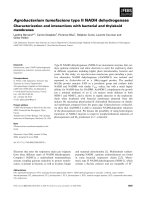
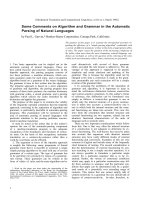
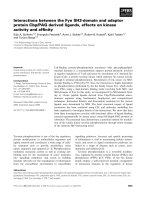
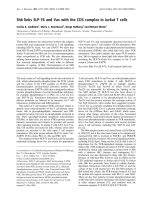
![Báo cáo khoa học: Accessory proteins functioning selectively and pleiotropically in the biosynthesis of [NiFe] hydrogenases in Thiocapsa roseopersicina docx](https://media.store123doc.com/images/document/14/rc/tv/medium_tvi1396203611.jpg)

